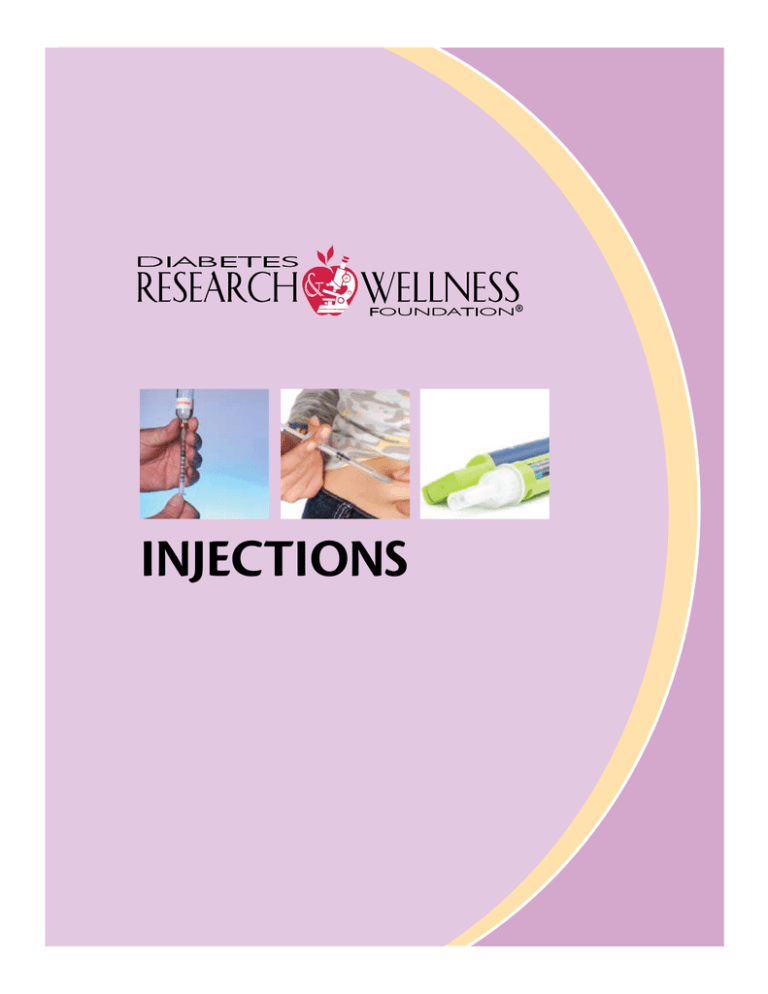injections - Diabetes Research and Wellness Foundation
advertisement

injections INJECTIONS / PRODUCTS Insulin is given by subcutaneous injection. The needle is injected into the fatty tissue just below the skin layer and above the muscle layer. It is important for each person to use the needle length and injection technique that best suits their needs. If you have a large amount of abdominal fat you may require a longer needle compared to someone who is very thin. Insulin can be injected anywhere there is subcutaneous fat. To ensure consistent absorption it is necessary to reduce the number of variables that may affect the absorption rate. The recommendation is to use your abdomen, as insulin seems to be absorbed there more consistently. Usually the surface area of the abdomen is large enough that insulin sites may be rotated without duplicating the site of injection for many days. When injecting into the abdomen, avoid any area with scar tissue and inject at least two finger widths away from your umbilicus (belly button). If you are exercising it is best not to use the thigh or arm because the increase in movement will hasten the absorption of the insulin and affecting your blood glucose levels. If you choose to rotate locations to different body parts, the same area (abdomen, arm, and thigh) should be used at the same time each day. Use ordinary soap and water to clean the area, as alcohol tends to harden the skin. No one is ever advised officially to inject through clothes, but many people do. Caution should be taken to ensure the site is free of dirt in order to avoid any infections. It has been shown in several studies that it is quite safe to re-use needles, but over time the sharpness of the needle dulls and the injection will be more painful. Syringes, insulin pens and needles should never be shared. Discomfort Individuals may experience discomfort at the time of injection if the injection is not deep enough. The area may become red or swollen; these symptoms will cease in a few hours. Individuals may also experience bleeding at the injection site. This occurs if a small blood vessel is broken. If the blood seeps into the surrounding tissue, you may notice some discoloration. This will resolve in a day. It may be necessary to use a slightly longer needle, or inject vertically rather than at a 45-degree angle to ensure the insulin is reaching the fatty layer. If you have very little subcutaneous fat it is better to pinch up the skin. This ensures that the needle goes deep enough to penetrate the skin layer but not so deep that it penetrates the muscle. Skin Irritation Allergic reactions to insulin injections are usually due to the chemicals in the solution rather than the insulin itself. Now that insulin preparations are highly purified, allergic reactions are very rare. Individuals may develop a slightly raised, red, itchy lump at the site of an injection. This most commonly occurs when someone first begins insulin therapy and usually resolves over time. If the itching is troublesome, notify your health care provider. Lipohypertrophy The most common cause of injection-site swelling (technically known as lipohypertrophy) occurs when insulin is injected into one site repeatedly. Fatty lumps do not carry a normal supply of nerves and blood vessels and so are not red or painful. Insulin injected into a fatty lump is absorbed more slowly and erratically. Lipohypertrophy may affect anyone who repeatedly injects in the same site. Lumps may range in size. To prevent lipohypertrophy it is necessary to rotate your injection sites and placement of insulin pump insertion sites. If you have fatty deposits or lumps it is important to completely stop using the affected area as an injection site. www.diab eteswellness .net Syringes Syringes are available in 3/10cc - 30 units, 1/2 cc - 50 units, and 1cc - 100 units. Use the syringe size that most closely complements the amount of insulin you are injecting, as the ability to visualize the markings will be easier to read. Some 3/10 cc syringes have half-unit markings that may be needed for children. Needles are available in two lengths - 5/16” (short), or 1/2” (long). Most individuals use the 5/16”needle; however, if you are obese you may need to use the longer 1/2” needle to improve the absorption of insulin. Needles are available in four gauges - 28, 29, 30, and 31. The higher the number the thinner the needle gauge. Insulin The long-acting insulins Lantus® and Levimer®, and the rapid-acting insulins Novolog®, Humalog®, and Apidra® need to be replaced one month after opening, as the synthetic insulins lose their potency after 30 days. It is important to date your insulin vial on the day that it is opened. Regular, NPH, and 70/30 insulins may be used for longer than 30 days if refrigerated. Insulin Pens Insulin pens are available in pre-filled disposable or reusable forms. Reusable pens have cartridges that are replaced within the pen. A pen needle is then screwed onto the pen and the prescribed dose is dialed in. Insulin pens contain 300 units of insulin. For individuals using a small amount of insulin this option may decrease the amount of insulin wasted each month. Insulin pens may also come in different shapes. Novo Nordisk® makes insulin-dosing devices similar to a pen but shaped differently. The InnoLet® uses a dial to set the dose. Insulin pen needles are available in three sizes: 5mm – 3/16”, 8mm – 5/16”, and 12.7mm – 1/2”. Pen needles should always be removed after using to prevent leakage of the medication. Key Points to Remember • • • • • • Store unopened insulin in the refrigerator. If your insulin is stored in extremes of temperature the potency of the insulin may be affected. Choose the appropriate size needle and insulin syringe. Always wash your hands and injection site with soap and water before injecting. Replace your Lantus®, Levemir®, Novolog®, Humalog® and Apidra® every 30 days. If you are using a insulin pump or a syringe you should rotate your injection sites. Fatty deposits and small painful lumps are preventable by rotating your injection sites. MEDIUM Speed FAST Speed SLOWER Speed INJECTION Sites S t a y in g H E A L T H Y until a cure is f ound . Available Insulin Syringe and Needles Sizes 3/10 cc Syringes 1/2 cc Syringes 1 cc Syringes 31 G x 8 mm (5/16”) 31 G x 8 mm (5/16”) 31 G x 8 mm (5/16”) 31 G x 8 mm (5/16”) 1/2 unit markings 30 G x 12.7 mm (1/2”) 30 G x 12.7 mm (1/2”) 30 G 12.7 mm (1/2”) 28 G x 12.7 mm (1/2”) 28 G x 12.7 mm (1/2”) 28 G x 12.7 mm (1/2”) For more information about diabetes contact DRWF’s helpline at 800-941-4635, or logon to our website at www.diabeteswellness.net. OTHER BROCHURES AVAILABLE: Your Feet and Diabetes, What is Diabetes, Illness and Diabetes, Injections, Periodontal Disease and Diabetes, Prediabetes, Erectile Dysfunction, The Facts About Diabetic Retinopathy. All rights reserved. 5151 Wisconsin Ave. NW, Suite 420 • Washington, D.C. 20016 www.diabeteswellness.net • www.diabeteslocal.org Helpline Questions 1-800-941-4635 • Administrative offices 202-298-9211 An Organization for People Who Live with Diabetes Every Day. The mission of Diabetes Research & Wellness Foundation (DRWF) is to help find the cure for diabetes, and until that goal is achieved, to provide the care and selfmanagement skills needed to combat the life-threatening complications of this terrible disease. Thank you for your confidence in the programs and services that the Diabetes Research & Wellness Foundation® provides to the community. Please designate us in the Combined Federal Campaign & United Way. Combined Federal Campaign #11629 • United Way #8588



